Light Travels Along A Straight Line
- Books Name
- CBSE Class 7 Science Book
- Publication
- Param Publication
- Course
- CBSE Class 7
- Subject
- Science
Introduction :
Light is the form of energy which makes object visible. It means that we can see an object only when light from an object enters our eyes. The light may have been emitted by the object or may have been reflected by it. You may have also seen beams of light from the torch, head light of vehicles.
Sources of Light :
Those bodies which emit light in all directions are called sources of light. The sources can be point one or extended one. The sources of light are of two types :
(i) Luminous sources : Those objects which by itself emit light are called luminous sources.
Eg. : Sun and stars (natural luminous sources), electric lamps, candles and lanterns (artificial luminous sources).
(ii) Non-luminous sources : Those objects which do not emit light but become visible only when light from luminous objects falls on them. They are called non-luminous sources.
Eg. : Moon, planets (natural non- luminous sources), wood, table (artificial non-luminous sources) etc.
Medium of Light :
Substance through which light propagates or tends to propagate is called a medium of light.
According to the medium of light objects are divided into three parts :
(i) Transparent object :
Bodies that allow light to pass through them i.e. transmit light through them, are called transparent bodies.
Eg. : Glass, water, air etc.
(ii) Translucent object : Bodies that can transmit only a part of light through them are called translucent objects.
Eg. : Froasted or ground glass, greased paper, paraffin wax etc.
(iii) Opaque object : Bodies that do not allow light to pass through them at all are said to be opaque objects.
Eg. : Chair, desk etc.
Properties of light :
(i) Light is invisible form of energy .
(ii) Light does not require material medium for its propagation i.e. light can travel through vacuum.
(iii) The speed of light in free space (vacuum) is 3 × 108 m/s. Its speed is marginally less in air. Its speed decreases considerably in glass or water.
Some definition related to the light :
(A) Ray of Light :
The path along which light energy travels in a given direction is called ray of light. A ray of light is represented as a straight line. The arrow head on it gives the direction of light.
![]()
(B) Beam of Light :
A collection of rays of light is called beam of light. However, if the number of rays is too small then such a collection of rays is called Pencil of light.
(C) Parallel Beam :
When the rays of light travel parallel to each other, then the collection of such rays is called parallel beam of light. For example, sun rays entering into a room through a ventilator constitute a parallel beam .

Rectilinear Propagation of Light :
Light travels in a straight line. In vacuum or air, light travels with the velocity of 3 × 108 m/s.
Examples of rectilinear propagation of light in everyday life :
(i) When the sunlight enters through a small hole in a dark room, it appears to travel in straight lines.
(ii) The light emitted by the head light of a scooter at night appears to travel in straight lines.
(iii) If we almost close our eyes and try to look towards a lighted bulb, it appears to give light in the form of straight lines, which travel in various direction.
Behaviour of light at the interface of two media :
When light travelling in one medium falls on the surface of a second medium, the following three effects may occur :
(i) A part of the incident light is turned back into the first medium. This phenomenon is called reflection of light.
(ii) A part of the incident light is transmitted into the second medium along a changed direction. This phenomenon is called refraction of light.
(iii) The remaining third part of light energy is absorbed by the second medium. This phenomenon is called absorption of light.
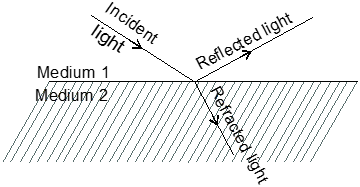
2. To prove that light travels in a straight line.
• Take three cardboards of similar size and make a hole in the centre of each. Make sure that the size and position of the hole is the same in each cardboard .
• Now put the three cardboards in vertical position with the help of a brick of plasticine or clay in such a way that the holes in the three cardboards are in a straight line.
• Place a lighted candle in front of the cardboards as shown in figure. Look through the hole of the last cardboard.
Are you able to see the flame of the lighted candle? What happens when you displace one of the cardboards?
The flame can be seen clearly through the holes in the first case. On diplacing one of the cardboards, no flame can be seen as light cannot bend.
Light travels in a straight line. No flame can be seen when the holes of the three cardboards are not in a straight line because light cannot bend.
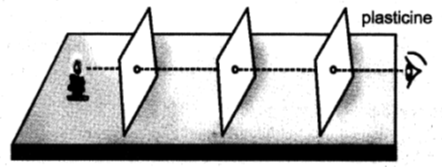
Light Travels Along A Straight Line
Chapter 15: Light
What is light in physics? Light is electromagnetic radiation that can be detected by the human eye. Electromagnetic radiation occurs over an extremely wide range of wavelengths, from gamma rays with wavelengths less than about 1 × 10−11 metres to radio waves measured in metres.
Light travels along a straight line
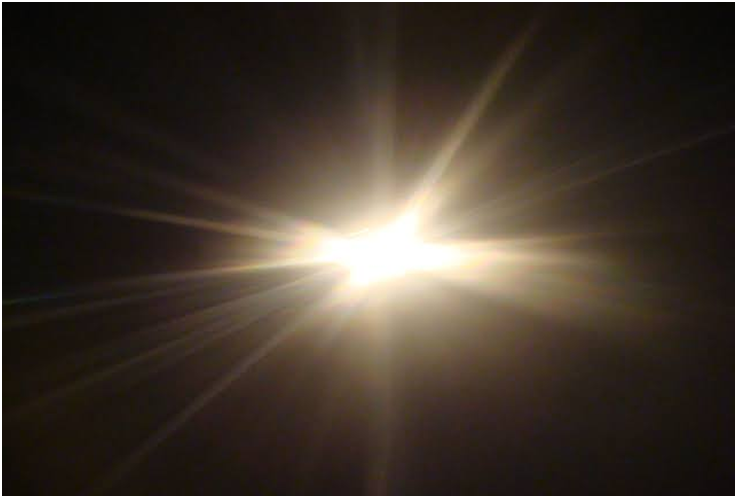
Light travels in a straight line because the diffraction effect is least due to the small wavelength of light. So the small wavelength of light produces negligible diffraction and therefore light travels along a straight line.
Reflection of Light
- Books Name
- CBSE Class 7 Science Book
- Publication
- Param Publication
- Course
- CBSE Class 7
- Subject
- Science
Reflection of light :
When a ray of light falls upon a smooth surface like a mirror, the ray of light is reflected in another direction in the same medium. This phenomenon is called reflection of light.
(a) General definitions about reflection :
(i) Mirror :
A smooth polished surface from which regular reflection can take place is called mirror. MM’ is the mirror as shown in figure.
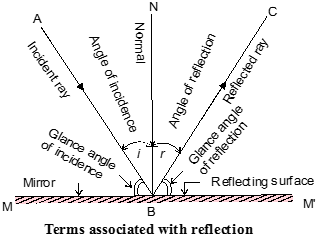
(ii) Incident ray :
A ray of light which travels towards the mirror is called incident ray. Ray AB is incident ray in figure.
(iii) Point of incidence :
The point on the mirror, where an incident ray strikes is called point of incidence. ‘B’ is the point of incidence in figure.
(iv) Reflected ray :
A ray of light which bounces off the surface of a mirror, is called reflected ray. BC is reflected ray in figure.
(v) Normal :
The perpendicular drawn at the point of incidence, to the surface of mirror is called normal. BN is the normal in figure.
(vi) Angle of incidence :
The angle made by the incident ray with the normal is called angle of incidence. ∠ABN is the angle of incidence in figure. It is denoted by ∠i.
(vii) Angle of reflection
The angle made by the reflected ray with the normal is called angle of reflection. ∠CBN is the angle of reflection in figure. It is denoted by ∠r.
(viii) Glance angle of incidence
The angle which the incident ray makes with the mirror is called glance angle of incidence.
∠MBA is the glance angle of incidence in figure.
(ix) Glance angle of reflection
The angle which the reflected ray makes with the mirror is called glance angle of reflection. ∠M’BC is the glance angle of reflection in figure.
Regular and diffused reflection :
When a beam of light falls on a smooth, highly polished surface, almost entire light gets reflected in the same medium in a definite direction. This type of reflection is called regular reflection. We can see our image formed by a mirror due to the phenomenon of regular reflection.

When a beam of light falls on an opaque, rough and uneven surface, the light gets reflected in different directions. This type of reflection is called irregular or diffused reflection. We can read a book or a newspaper due to diffused reflection.
Laws of Reflection :
The reflection of light from a surface obeys certain laws called laws of reflection. They are :
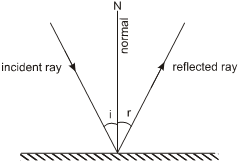
(i) The angle of incidence is equal to the angle of reflection. i.e., ∠i = ∠r.
(ii) The incident ray, the reflected ray and the normal at the point of incident, all lie in the same plane.
The laws of reflection are applied for all type of reflections.
Ex.1 Calculate the angle of reflection.
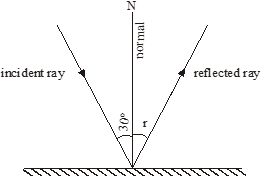
Sol. According to the law of reflection, incident angle equal to reflected angle. So angle of reflection ∠r = 30°.
Reflection of Light
Reflection of light
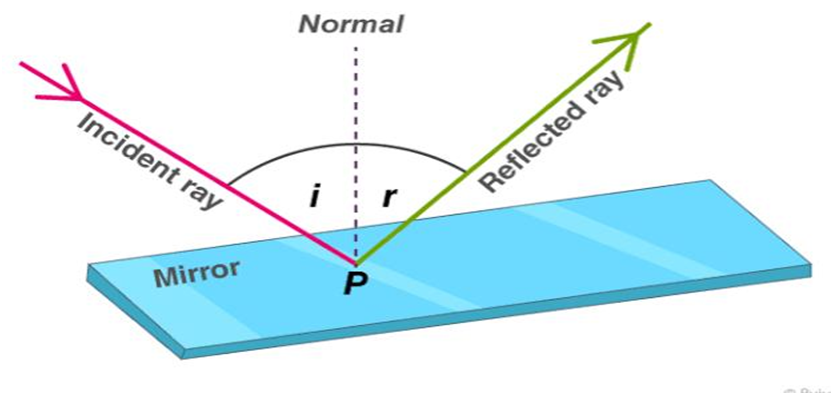
When a ray of light approaches a smooth polished surface and the light ray bounces back, it is called the reflection of light. The incident light ray that land on the surface is reflected off the surface. The ray that bounces back is called the reflected ray
Right or Left!
- Books Name
- CBSE Class 7 Science Book
- Publication
- Param Publication
- Course
- CBSE Class 7
- Subject
- Science
Refraction of light :
When light travels in the same homogeneous medium, it travels along a straight path. However, when it passes from one transparent medium to another, the direction of its path changes at the interface of the two media. This is called refraction of light.
The phenomenon of the change in the path of the light as it passes from one transparent medium to another is called refraction of light. The path along which the light travels in the first medium is called incident ray and that in the second medium is called refracted ray. The angles which the incident ray and the refracted ray make with the normal at the surface of separation are called angle of incidence (∠i) and angle of refraction (∠r) respectively.
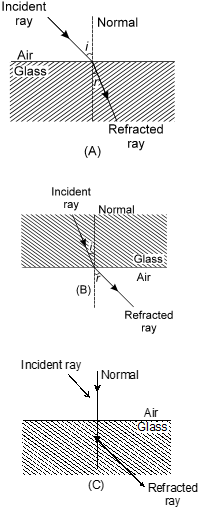
• It is observed that :
(i) When a ray of light passes from an optically rarer medium to a denser medium, it bends towards the normal (∠r < ∠i ), as shown in figure (A).
(ii) When a ray of light passes from an optically denser to a rarer medium, it bends away from the normal (∠r > ∠i) as shown in figure (B) .
(iii) A ray of light travelling along the normal passes undeflected, as shown in figure (C). Here ∠i = Ðr = 0°.
Cause of Refraction :
Refraction occurs because the speed of light is different in different media. Light travels with a greater velocity in a rarer medium like air and with lower velocity in a denser medium like glass or water.
The lower the velocity of light in the medium than that in air, the greater the bending because the greater would be the need to take a shorter path.
Right or Left!
Right or left
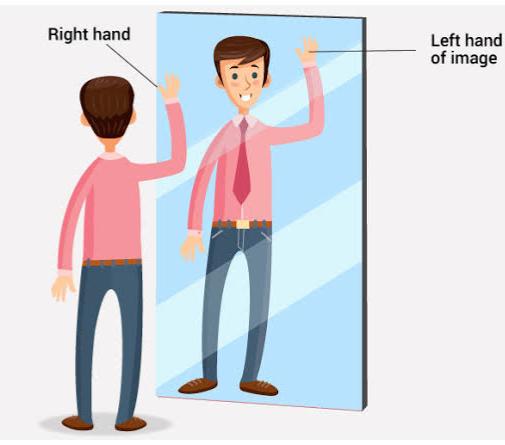
When Barack Obama promised in his 2009 inaugural address that “we will restore science to its rightful place,” he invoked not so much a debate as a set of widely shared assumptions. According to conventional wisdom, liberals and Democrats are the party of reason and science; conservatives and Republicans are the party of religion and patriotic symbols. As Drew Westen, a psychotherapist, recently expressed it in a New York Times op-ed, “Whereas Democrats have carried forward the belief in the role of science and knowledge in improving our lives, Republicans have moved in increasingly anti-intellectual directions.” This way of stating the division, needless to say, is itself liberal and Democratic. While many conservatives (with notable exceptions) agree that religion is an important source of beliefs and public policies, probably few consider themselves anti-intellectual. Yet the impression that the physical and social sciences are to liberalism what religion is to conservatism goes mostly unquestioned on either side.
Playing with Spherical Mirrors
- Books Name
- CBSE Class 7 Science Book
- Publication
- Param Publication
- Course
- CBSE Class 7
- Subject
- Science
Mirror :
It is a highly polished surface, which is quite smooth and capable of reflecting a good fraction of light from its surface.
(a) Object :
Anything which gives out light rays (either its own or reflected) is called an object.
(b) Image :
The reproduction of object formed by mirror or lens is called an image.
ReaL and virtual images :
The image which can be obtained on a screen is called a real image. It is formed when light rays, after reflection, actually intersect each other. It is always inverted.
The image which cannot be obtained on a screen is called a virtual image. It is formed when light rays, after refection, intersect when extended in backward direction. Its is always erect.
Plane Mirror:
Image Formation by Plane Mirror :
Consider a point source of light placed at a point O at a distance u in front of the plane mirror. Light rays leave the source and are reflected from the mirror. After reflection, the rays diverge but they appear to come from a point I located behind the mirror. Point I is called the image of the object O. Point I is at a distance v behind the mirror.
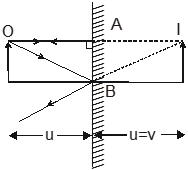
Character Stics of Image :
(i) Image is virtual, erect and of the same size as object.
(ii) It is as far behind the mirror as the object is in front of it
(iii) Laterally inverted : When left appears right and right appears left.
Note :
(i) Minimum size of the mirror required to see full image of a person is at least half of his own height.
(ii) If object moves with a speed V towards plane mirror then image moves with a speed 2V towards object.
(iii) If mirror moves with a speed V towards stationary object then image moves with a speed 2V towards object.
Uses of Plane Mirror
* In looking mirrors, hair saloons, reflecting periscopes & kaleidoscopes.
Spherical Mirrors :
Mirrors, whose reflecting surfaces are spherical or curved, are called spherical mirrors. These are of two types:
(i) Concave mirror: If the reflecting surface of the spherical mirror is curved inwards, it is called a concave mirror. The image formed by a concave mirror can easily be taken on the screen. You must have played with concave mirror to obtain image of sun on the ground or wall by positioning it to in a specific way. It means a concave mirror can form real or virtual image. In concave mirror when a parallel beam of light after reflection from a concave mirror converges at a point in front of the mirror. Due to this it is known as converging mirror.
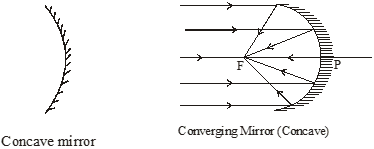
(ii) Convex mirror: If the reflecting surface of the spherical mirror is curved outwards, it is called a convex mirror. It means a convex mirror always forms virtual image. In convex mirror when a parallel beam of light after reflection from a convex surface diverges and the rays do not meet. Due to this it is known as diverging mirror.
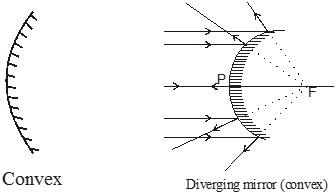
Some terms related to Spherical Mirrors :
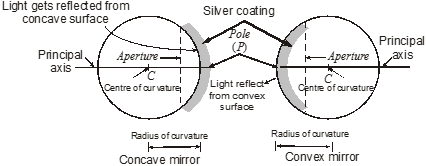
(i) Pole : The central point of a mirror is called its pole.
(ii) Centre of curvature : The centre of the sphere of which the mirror is a part, is called centre of curvature.
(iii) Radius of curvature : The radius of the sphere of which the mirror is a part, is called radius of curvature.
(iv) Principal axis : The straight line joining the pole and the centre of curvature is called the principal axis.
(v) Focal length : The distance between the pole and the focus is called the focal length. The focal length is half of the radius of curvature.
(vi) Aperture : The size of the mirror is called its aperture.
(vii) Focus point :
(a) In concave mirror when a parallel beam of light after reflection from a concave mirror converges at a point in front of the mirror. This point (F) is the focus of a concave mirror and it is real.
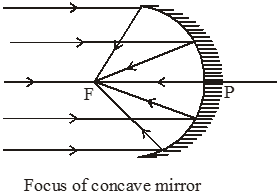
(b) when a parallel beam of light after reflection from a convex surface diverges and the rays do not meet. However on producing backward, the rays appear to meet at a point behind the mirror. This point is focus of the convex mirror and it is virtual.
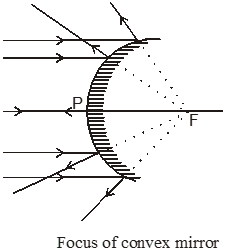
Uses of Concave Mirror :
(i) Concave mirror is used by doctors for examining eyes, ears, nose and throat.
(ii) They are also used by dentist to see an enlarged image of the teeth.
(iii) The reflector of torches, headlights of cars and scooters are concave in shape.
Uses of Convex Mirror :
(i) Convex mirrors are used as rear view mirrors to see the vehicle coming from behind. These mirror covers a wider view and form upright small size (diminished) image.
(ii) They are used as reflector in street lamps so as to diverge light over a large area.
Playing with Spherical Mirrors
Playing with spherical mirrors
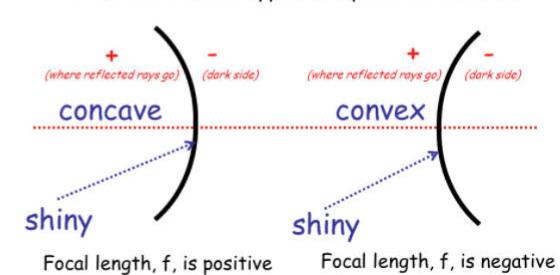
Spherical mirrors are used by all in day-to-day life. It is important that students have a better understanding of the application of spherical mirrors so that they grasp the concept properly. Students often find problems when dealing with the concept because it can prove to be complicated. A spherical mirror is a mirror that has the shape of a piece cut out of a spherical surface. There are two types of spherical mirrors: concave and convex mirror.
Images Formed by Lenses
- Books Name
- CBSE Class 7 Science Book
- Publication
- Param Publication
- Course
- CBSE Class 7
- Subject
- Science
Cause of Refraction :
Refraction occurs because the speed of light is different in different media. Light travels with a greater velocity in a rarer medium like air and with lower velocity in a denser medium like glass or water.
The lower the velocity of light in the medium than that in air, the greater the bending because the greater would be the need to take a shorter path.
Refraction through spherical lenses :
A lens is a piece of transparent refracting material bounded by two spherical surfaces or one spherical and other plane surface.In case of a lens, the light rays do not bounce off its surface, instead, the light rays pass through it but in doing so they change their path i.e., they bend from their original path.
A lens is the most important optical component used in microscopes, telescopes, cameras, projectors etc.
Basically lenses are of two types :
(i) Convex lens or converging lens
(ii) Concave lens or diverging lens
(a) Convex Lens :
A lens which is thick at the centre and thin at the edges is called a convex lens. The most common form of a convex lens has both the surfaces bulging out at the middle. When a convex lens is held close to an object, it always forms an enlarged, virtual and erect image. In a convex lens, when rays parallel to principal axis falls on lens after refraction they meet or appears to meet at a point. So due to this it is known is converging lens.
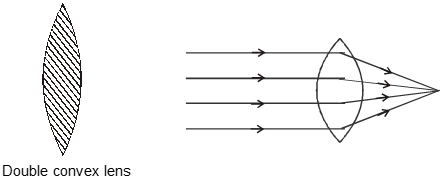
(b) Concave Lens :
A lens which is thin at the middle and thick at the edges is called a concave lens. The most common form of a concave lens has both the surfaces depressed inward at the middle. When a concave lens is held close to an object, it always forms a diminished, virtual and erect image.In a concave lens, when rays parallel to principal axis falls on lens after refraction they move away from the lens. So due to this it is known is diverging lens.
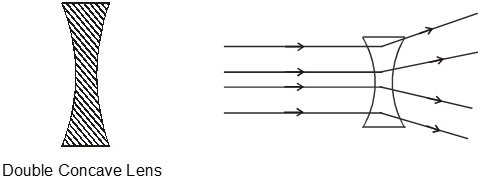
(c) Definitions in connection with Spherical Lens :
(i) Centre of curvature : The centre of curvature of the surface of a lens is the centre of the sphere of which it forms a part, because a lens has two surfaces, so it has two centres of curvature. In figure (a) and (b) points C1 and C2 are the centres of curvature.
(ii) Radius of curvature : The radius of curvature of the surface of a lens is the radius of the sphere of which the surface forms a part. R1 and R2 in the figure (a) and (b) represents radius of curvature.
(iii) Principal axis : It is the line passing through the two centres of curvature (C1 and C2) of the lens.
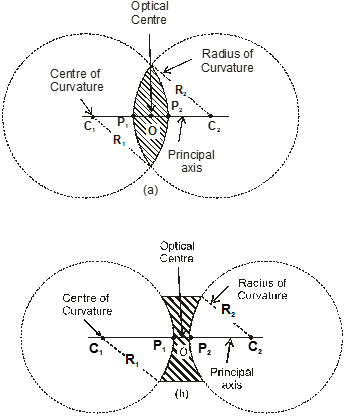
(iv) Optical centre : If a ray of light is incident on a lens such that after refraction through the lens the emergent ray is parallel to the incident ray, then the point at which the refracted ray intersects, the principal axis is called the optical centre of the lens. In the figure O is the optical centre of the lens.
If the radii of curvature of the two surfaces are equal, then the optical centre coincides with the geometric centre of the lens.

(v) Focus point and focal length : When rays parallel to principal axis falls on lens after refraction they meet or appears to meet at a point on principal axis, this point is known as principal focus. The distance between optical centre and focus point is known as focal length.
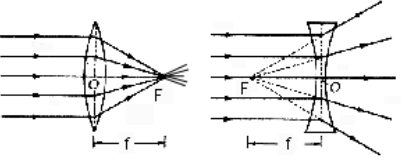
Images Formed by Lenses
Images formed by lenses
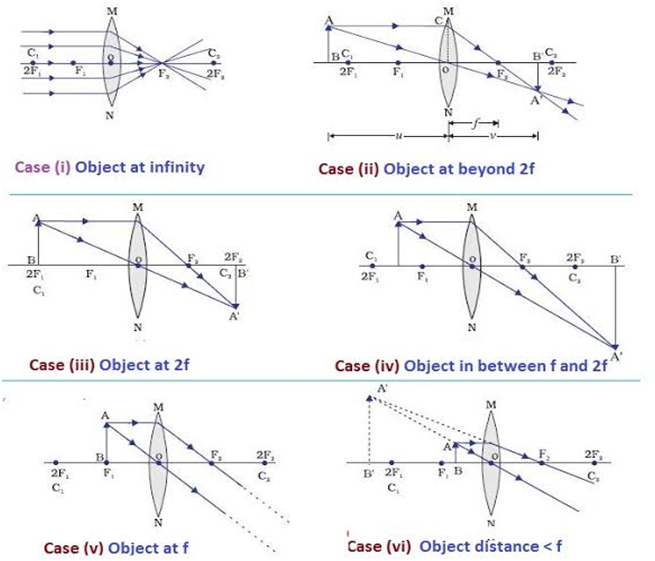
A lens is a part of a transparent thick glass which is bounded by two spherical surfaces. It is an optical device through which the rays of light converge or diverge before transmitting.
A convex lens is thicker in the middle and thinner at the edges. A convex lens is also known as a “biconvex lens” because of two spherical surfaces bulging outwards.
A concave lens is thicker at the edges and thinner in the middle. A concave lens is also known as a “biconcave lens” because of two spherical surfaces bulging inwards.
Sunlight — White Or Coloured?.
- Books Name
- CBSE Class 7 Science Book
- Publication
- Param Publication
- Course
- CBSE Class 7
- Subject
- Science
Sunlight White or Coloured :
There are many phenomenons in which we can see sunlight is white or coloured. The followings are given below :
(a) Rainbow :
White light is composed of seven colours, e.g., violet, indigo, blue, green, yellow, orange and red. Phenomenon of appearance of rainbow in the sky is a proof of seven colours. A rainbow appears usually after rain in the morning or evening when the sun is low in the sky. It is formed when white light.from the sun passes through tiny prism-like water droplets and splits into different colours. -This phenormeon of splitting of white light into several different component of colors is called dispersion of light. A rainbow is arch-shaped. There are seven colours in the rainbow which gradually change from one to another. The set of colours formed on splitting of white light is called the spectrum of white light. They are seen in the order VIBGYOR, i.e., violet, indigo, blue, green, yellow, orange and red.
Since white light splits into seven colours, we should be able to get white light by mixing the seven colours ofa rainbow.
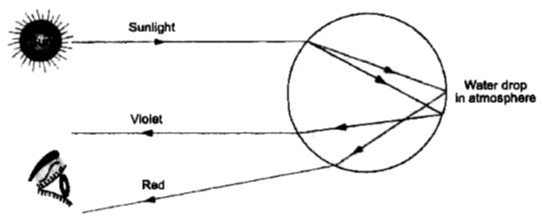
(b) Glass prism :
If we take a glass prism, and put a narrow beam of sunlight through a small hole in the window of a dark room, so, we can easily see a colourful band on the paper or screen or wall.
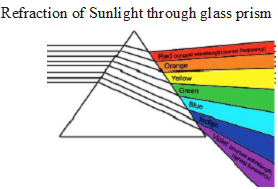
This shows that light consists of seven colours. If we take another prism and place it in upside down position with respect to first prism, we again get a beam of white light.
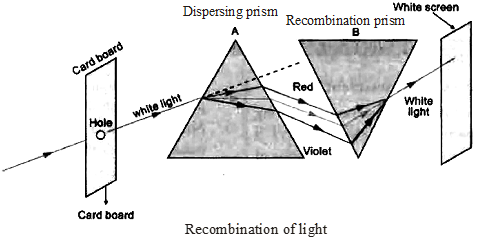
(c) Newton's Disc :
The famous English physicist Sir Isaac Newton for the first time explained this phenomenon of mixing. To prove his point, he made a disc on which the seven colours of the rainbow were painted in equal sections as shown in figure. When' this disc was rotated, all the colours disappeared and white colour appeared. This is because when the disc spins fast, all the colours pass through a spot rapidly one followed by the other. This gives the effect of putting all the colours together in one place. The colours mix and appear white. Such a disc is popularly known as Newton's disc.
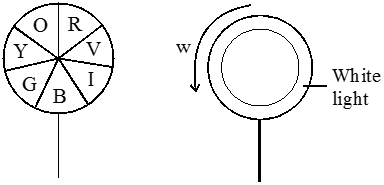
On the basis of these experiments it is confirmed that white light is made of seven colours (VIBGYOR).
Sunlight — White Or Coloured?.
Sunlight - white or coloured ?
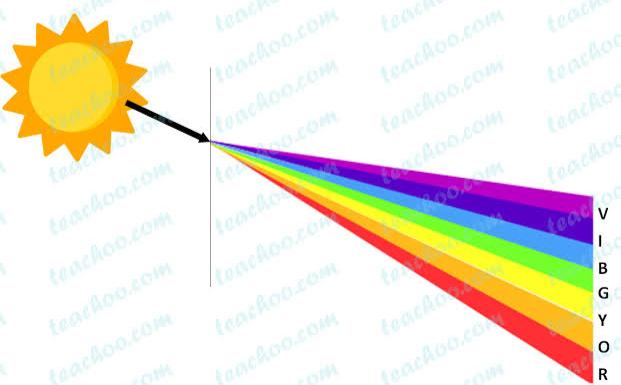
The colour of the sun is white. The sun emits all colours of the rainbow more or less evenly and in physics, we call this combination “white”. That is why we can see so many different colours in the natural world under the illumination of sunlight.

 Param Publication
Param Publication
 Grow Career Publication
Grow Career Publication
